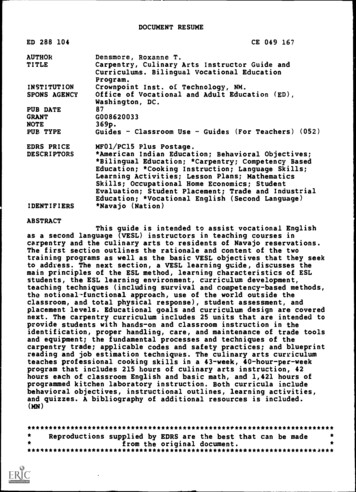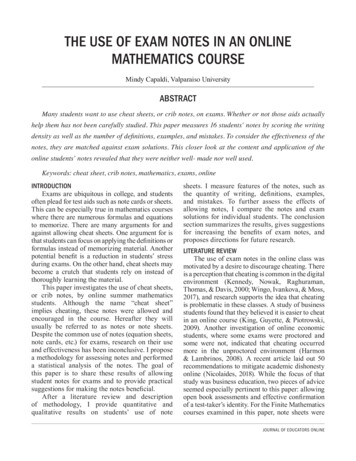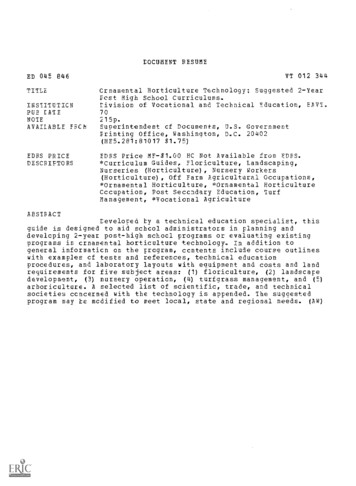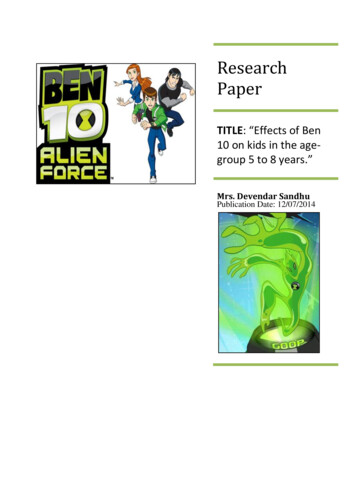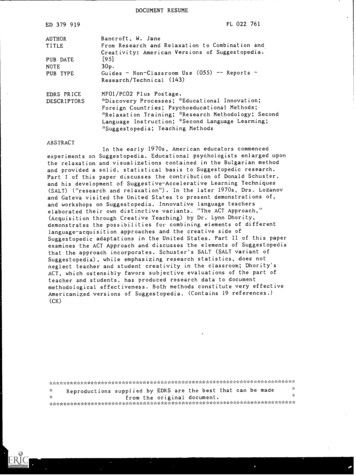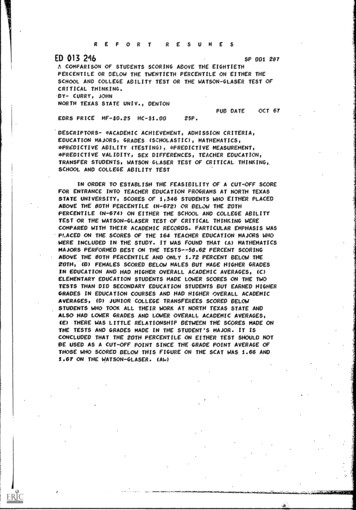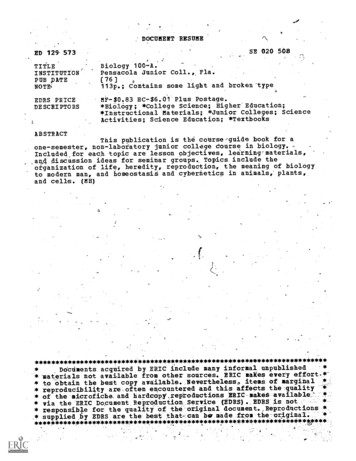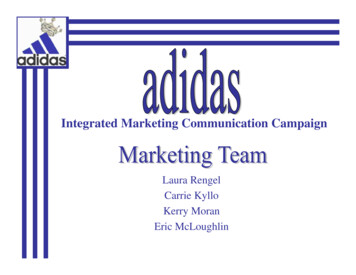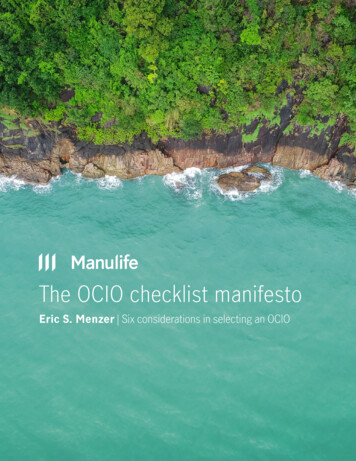
Transcription
The OCIO checklist manifestoEric S. Menzer Six considerations in selecting an OCIO
The OCIO checklist manifestoSix outsourcing considerations for pension plan sponsorsKey takeaways As more organizations sharpen the focus on their core competencies, manyare starting to question the cost-effectiveness of maintaining large in-houseinvestment departments, and many firms are seeking the help of outsideexpertise in navigating today’s complex markets. The outsourced chief investment officer (OCIO) fiduciary model is gainingtraction among pension plan sponsors and other institutional investors,as worldwide OCIO assets under management grew to over 1.5 trillion in2017, up more than 14% from the prior year.¹Eric S. Menzer, CFA, CAIA, AIFGlobal Head of Pension andFiduciary Solutions,Manulife Investment Management While pension plan sponsors are intrigued by the prospect of an externaldiscretionary partner to serve as a co-fiduciary, many are bewildered by thedifferent permutations of OCIO services available and uncertain about what—exactly, they really need.Executive summaryWith the increasing stringency of fiduciary standards and the growing complexity of financial markets,fewer institutions today are willing to go it alone when it comes to managing their own investments,whether the assets reside in a pension plan to support the organization’s employees or an endowmentfund to support its operating budget. Consultants have long aided institutional investors in need of advice,but more OCIO providers are stepping forward with comprehensive fiduciary services combining advice,portfolio management, and plan administration—all through a single point of contact. OCIO assets undermanagement in the United States alone are projected to reach nearly 1.7 trillion by 2023.¹ While theword is clearly getting out, many institutional investors still wrestle with the best ways to match theirspecific needs with the right combination of OCIO service options available from different providers in themarketplace. Fully funded or not, each pension plan is unique, requiring its own specific combination ofOCIO service capabilities. Here, we offer a checklist of six items a plan sponsor can consider to maximizethe odds of engaging an OCIO with the capabilities and expertise best suited to help bridge the gap.FOR INSTITUTIONAL/PROFESSIONAL USE ONLY. NOT FOR DISTRIBUTION TO THE PUBLIC. 2
1 Asset allocation credentials are essentialIt’s not easy being a defined benefit plan sponsor these days. “The latest dive in interest rates pushed the global stock ofnegative-yielding debt above 15 trillion for the first time,” representing roughly a quarter of all outstanding bonds aroundthe world—a development that “further complicates the life for pension funds,” according to Grant’s Interest Rate Observer.²Investments with expected rates of return sufficient to meet projected liabilities are becoming harder to find, which makesasset allocation that much more crucial. The average U.S. corporate pension plan now stands at less than 84% funded,down from 94% in September 2018.³ Pairing increasingly onerous legal and regulatory burdens against a macro backdroprife with historical anomalies, it’s no wonder plan sponsors are growing uncomfortable going it alone.While devoting greater resources toward core business capabilities has become a competitive imperative, many nonfinancialorganizations lack in-house staff with the asset allocation expertise needed to navigate an upside-down investment worldpopulated with subzero yields. Not surprisingly, the majority of institutional investors (51%), including 53% of corporatedefined benefit plans, identified asset allocation as the most valued investment service provided by OCIOs.⁴ Asset allocationdecisions should take into account a plan’s characteristics, its asset-liability mismatch, its current yields, and its mostoptimal path toward return expectations that meet its discount rate.Even an organization backed by a strong investment committee that meets quarterly may benefit from the agility afforded byday-to-day external discretion. “Formerly, it was hard to react when an investment opportunity would present itself. By usingan OCIO we are creating structural expertise that helps us with these one-off ideas,” notes one investment committee chair.⁴Asset allocators have the potential to add alpha and control risk by dynamically seizing the opportunities that unexpectedmarket dislocations provide. A seasoned multi-asset solutions team with an extensive active asset allocation record usingin-house and third-party strategies across many different public and private asset classes may provide plan sponsors with animproved efficient frontier and a better hedge ratio over time.While strong consulting credentials might be sufficient in the context of a limited engagement advisory relationship,some “OCIOs are consulting firms that have expanded into the field of outsourcing to increase their fees.”⁵ Full fiduciaryresponsibility is probably best left to OCIO firms designed with asset allocation in their DNA right from the start.CHECKPOINTFavor OCIOs with a history of asset allocation leadership and innovation.Asset allocation and manager research top the list of client needsTotalNonprofitsCorporate DBplansManager due diligence selection/termination51%52%47%Asset allocation (strategic and/or tactical)51%43%53%Alternative investment capabilities and access to top-tier managers(including co-investing)24%48%0%Pension-specific capabilities (LDI, custom glide path)24%0%58%Purpose-driven investing (ESG)9%14%0%Execution4%5%5%16%24%5%Investment servicesOtherSource: “OCIO at an Inflection Point,” Cerulli, 2019.The OCIO checklist manifestoFOR INSTITUTIONAL/PROFESSIONAL USE ONLY. NOT FOR DISTRIBUTION TO THE PUBLIC. 3
2 Multimanager diversification requires robust manager researchWhen it comes to managing an institutional portfolio, asset allocation might be among the most important things, but it’s not theonly important thing. In fact, 51% of all institutional investors identified manager due diligence, selection, and termination as themost valued investment service provided by OCIOs, an acknowledgment that diversification should extend beyond asset classesand include multiple investment styles from multiple investment firms.⁴ As capital markets have become increasingly complexand more institutions have come to embrace private investments and other alternative assets, no single organization today canreasonably expect to achieve proficiency in every investment discipline needed to help build a truly diversified portfolio.Devoting all assets to a single underlying manager entails risksIn addition to potentially forfeiting niche market opportunities, pension funds that consolidate their assets with only one assetmanagement firm for all of their underlying investments may introduce an unintended degree of manager concentration risk. Anacademic study on management structure at investment firms suggests a strong link between hierarchy and herding, the tendencyof portfolio managers to follow the trading behavior of their colleagues.⁶ In particular, a firm with a vertical structure, where houseviews are mandated from the top down, can impair a portfolio manager’s discretion and sense of empowerment, weakening theincentive to cultivate original insight. And when all of a firm’s portfolio managers rely on the same central research group, it’s fair toquestion how they guard against groupthink. An OCIO provider offering a robust open-architecture platform featuring third-partymanagers sends a strong signal to prospective clients about its commitment to minimizing conflicts of interest, maintaining highfiduciary standards, and creating a broad range of investment opportunities—all while reducing manager concentration risk.Not all OCIOs are resourced for global investment manager researchBut aspiration isn’t execution. Implementing multimanager diversification in practice requires substantial research and oversightresources, including a dedicated staff specializing in investment manager due diligence and oversight, and advanced analyticsand performance attribution systems. Despite their good intentions, some OCIO providers just don’t have the scale to maintainmanager research coverage spanning scores of talented investment teams and the hundreds of different strategies that they run.Only some providers routinely engage third-party specialized “managers with expertise outside their own, particularly in alternativeassets and private market investments.”¹ An OCIO is only as good as the asset manager network it’s able to bring to bear on behalfof its client accounts.CHECKPOINTFavor OCIOs that bring together some of the best investment teams from around the world.Open-architecture fund construction helps mute manager concentration riskOversightn OversightMonitoring each portfolio team for the repeatability of itsMonitoringportfolioteam for the repeatabilityof its investment processinvestment eachprocessand managementof riskand management of riskOversightn MultipleMultiple assetasset classesclassesBoth withinwithin andand ndfixedfixedincomeincomeBothU.S. large-cap equityValuen MultipleMultiple stylesstylesexposure differentdifferentcharacteristics go inContinual exposurecharacteristicsandout of favor go in and out of favorBoston Partnersn MultipleMultiple managersmanagersBarrow HanleyA diversitys bestmanagersdiversity ofof d’world’sbestmanagersCoreGrowthJennisonT. Rowe PriceManulife Investment ManagementSource: John Hancock Investment Management, 2019. For illustrative purposes only.The OCIO checklist manifestoFOR INSTITUTIONAL/PROFESSIONAL USE ONLY. NOT FOR DISTRIBUTION TO THE PUBLIC. 4
3 Private-market assets can pair well with long-duration obligationsOver 60% of alternative asset holders believe we’re near the peak of the equity market cycle.⁷ Still, the average corporate definedbenefit plan remains less than 84% funded.³ What’s the game plan to close the gap? Most mainstream asset classes probablywon’t do the trick; “with the bond market offering microscopic yields (at best) and the S&P 500 trading at a substantial premiumto its five-year average on price-to-earnings basis, pension funds look primarily to the private markets to make up the shortfall.”² Infact, 70% of U.S. corporate defined benefit plans expect to increase their allocations to real estate, infrastructure, private debt,and other private investments over the next year; meanwhile, 78% plan to decrease their allocations to public equity markets overthe same period.¹Private investments span diverse asset classes across the capital spectrum, yet they all share a common feature—they’re notpublicly traded. As a result, private assets can offer an opportunity to pursue an illiquidity premium over stocks, with lower dayto-day price volatility along the way. Increases in allocations to “defensive positions that are less correlated with public marketinvestments” are anticipated across a variety of “client types with longer-term investment horizons that are willing to trade liquidityfor higher returns than are available in public markets.”¹ Across the endowment and foundation world, too, the allure of privateassets remains as strong as the aversion toward public equities. Over the next year, 6 of every 10 U.S. endowment funds expect toincrease allocations to real estate, infrastructure, private debt, and other private investments while decreasing allocations to publicequities.¹ Nearly a third (31%) of nonprofits report a greater need for opportunities to allocate capital to private-market strategiesas a co-investor alongside their OCIO provider.⁴ Candidates affiliated with insurance companies often have a leg up in this regardsince they can frequently offer clients the same private-market strategies the insurer deploys on its balance sheet to meet its ownfinancial obligations.CHECKPOINTFavor OCIOs armed with an arsenal of alternatives, fortified by private-market expertise.Real estate, infrastructure, and other private investments are on the riseCanadian institutions’ expected allocation shifts over next three yearsCanadian equities—activeCanadian equities—passive37%Non-Canadian equities—activeNon-Canadian equities—passiveGlobal equity—activeEmerging markets equity16%20%Canadian bonds—activeCanadian bonds—passiveNon-Canadian bondsGlobal fixed income—activeEmerging markets debt3%2%11%21%Direct real estateListed real estate (REITs)Real estate fund of fundsInfrastructureDirect private equityPrivate Equity fund of fundsDirect hedge fundsHedge fund of %2%2%50%13%5%5%8%0%15%25%27%50%Proportion of Canadian institutionsSignificantly decreaseSignificantly increaseSource: Canadian Institutional Investors Research, Greenwich Associates, 2018.The OCIO checklist manifestoFOR INSTITUTIONAL/PROFESSIONAL USE ONLY. NOT FOR DISTRIBUTION TO THE PUBLIC. 5
4 Liability-driven investing is indispensable for pension risk managementGiven where we are in the market cycle, many corporate defined benefit plans see now as the time to upgrade their riskmanagement capabilities through dynamic glide paths, completion mandates, derivative overlays, and other liability-driveninvestment (LDI) strategies. Whereas the absolute asset price volatility often represents the most prominent definition of risk fortotal return investors, asset price volatility relative to the liability stream remains the risk most likely to instill insomnia for pensionplan sponsors. Here again, OCIOs affiliated with insurance companies have a clear edge over candidates that aren’t so well versedwith the liability side of a balance sheet.Long duration government bonds have historically served as the bread and butter of pension fund LDI, and debt remains indemand—over two-thirds of defined benefit plans anticipate increasing their fixed-income allocations over the next year.¹ Still,abnormally low and even negative sovereign bond yields have left plan sponsors “forced into increasingly ‘creative’ measures tomaintain rates of return sufficient to meet their obligations.”² Insurers have been facing the same type of asset liability matchingchallenge for years. An OCIO with a heritage of risk management, deep actuarial expertise, and a wide range of derisking andreturn-enhancing tailored solutions may be better equipped to help a plan sponsor achieve its target objectives, even as theychange over the pension fund’s lifecycle.Pension fund asset allocation can’t exist in a vacuum. Dynamic glide path management is an active derisking approach, wherebythe asset mix is adjusted gradually, based on client-specific fund characteristics, in an effort to narrow the gap between the presentvalue of a plan’s assets and its liabilities over time. Over half of all U.S. OCIO-managed corporate defined benefit plan assets are ona glide path of some sort.¹For plan sponsors lacking such sufficient skills internally, finding an OCIO capable of tailoring and implementing an LDI approachcan increase the odds of better outcomes over the long run. A good LDI process requires an integration of quantitative andactuarial insight with client-specific considerations concerning objectives and constraints. By maintaining a collaborative LDIprogram throughout the life of the plan, a joint client-OCIO partnership can explore enhancements and make adjustments to meetthe changing needs of the plan over its lifecycle.CHECKPOINTFavor OCIOs that recognize a plan’s investment strategy starts with its liability profile.Proportion of Canadian InstitutionsLiability management is among the top three concerns among Canadian corporate plansProportion of Canadian corporations facing three key issues, 2017 and et allocation20172018Rate of returnand funding issues20172018LiabilitymanagementSource: Canadian Institutional Investors Research, Greenwich Associates, 2018.The OCIO checklist manifestoFOR INSTITUTIONAL/PROFESSIONAL USE ONLY. NOT FOR DISTRIBUTION TO THE PUBLIC. 6
5 Administrative acumen is central to comprehensive plan managementA truly comprehensive OCIO-plan sponsor relationship doesn’t end with investment policy advice, asset allocation implementation,manager selection, or customized portfolio solutions. While plan sponsors often overlook the capability to conduct administrationservices in the search for the right OCIO, such an omission can prove immensely inconvenient—and costly—in the long run,especially for pension plans with a large number of participants. Administrative offerings run the gamut in the OCIO marketplace.Some providers offer virtually none while others can combine integrated front-, middle-, and back-office functions ranging fromforeign exchange and securities trading, actuarial and defined benefit recordkeeping services, transition management, custodialservices oversight, transactional and financial reporting, securities lending, and equitization of cash. Only insurers can providecomprehensive pension administration services in Canada, and a strong OCIO provider can provide its clients with an advantage incoordinating communications with the custodian and handling all activities associated with pension payments on the plan’s behalf.Clients value custody, recordkeeping, and trading relationships and other ancillary support services, such as reporting andtechnology—especially if they can be accessed through a single point of contact. An executive at a 1.3 billion corporate definedbenefit plan observed that “our fee structure is better than it was pre-OCIO, and when you add on top of that the fact that you getthe portfolio expertise and administrative support, it just makes a lot of sense” (emphasis added).⁴ Some OCIOs may be able toserve one or more facets of a plan’s management, but relatively few can bring together all the essentials of operational excellenceinto a holistic solution that includes administrative services. Still, if they make the effort to find the right partner, plan sponsors canbenefit from complete OCIO plan management bolstered by administrative efficiencies, cost controls, and economies of scale thatonly come with significant consolidations in pension plan services purchasing power.CHECKPOINTFavor OCIOs offering complete plan management—down to the last administrative detail.Institutions desire more than investing from their OCIO providers2%Service model31%Investment capabilities7%Operational 0%80%100%Very satisfiedSource: “OCIO at an Inflection Point,” Cerulli, 2019.The OCIO checklist manifestoFOR INSTITUTIONAL/PROFESSIONAL USE ONLY. NOT FOR DISTRIBUTION TO THE PUBLIC. 7
6 OCIO search consultants can help if you get stuckFinding the right OCIO partner isn’t easy for pension plans and other institutional investors. Ratherthan a perfect science, striking the right match is more of an iterative art. And it’s not only prospectiveclients that get confused: 84% of U.S. OCIO providers also view the “lack of a developed process forsearching, evaluating, and selecting OCIO services” as a challenge.¹ That may change as the OCIOmarket matures and as its professional matchmakers continue to gain momentum and establisha more prominent role in the shaping of OCIO search best practices. Across the universe of OCIOproviders, 45% report seeing only a small sliver of prospective client searches—less than onequarter—tied to OCIO search consultants, while 42% estimate that one-quarter to one-half of thesearches they encounter come from consultants. The remaining 13% of the OCIO providers see amajority of searches led by consultants.¹ These numbers are expected to shift. We expect searchconsultants to fare well as the volume of informal market checks, rebids, and full-blown replacementsearches grows along with the maturity of the OCIO marketplace. Many OCIO clients that didn’t initiallyuse a search consultant report plans to do so in the future because they believe it will help them savetime, review a larger number of providers, and conduct a more efficient search.¹CHECKPOINTWhen in doubt, seek out an OCIO search consultant to help you strike the right match.What to do nowIn theory, finding the right OCIO seems like a fairly straightforward exercise. But challenges arise in thepractice of identifying service providers with the right mix of expertise, judgment, and technical skills.Each pension fund is unique, requiring its own specific combination of OCIO service capabilities. Here, webriefly recap our checklist of key items a plan sponsor can consider when seeking out the right OCIO forthe job. Favor OCIOs that:1.Demonstrate an extensive track record of asset allocation leadership and innovation2.Bring together some of the best investment teams from around the world3.Arm clients with an arsenal of alternative investments, fortified by private-market expertise4.Recognize a plan’s investment strategy should be developed in light of its liability profile5.Offer comprehensive plan management—right down to the last administrative detail6.Earn and deserve the respect of the OCIO search consultant community as the investmentoutsourcing market matures, with search consultants playing a more prominent role in it1 “U.S. Outsourced Chief Investment Officer,” Cerulli, 2018. 2 Almost Daily Comment, Grant’s Interest Rate Observer,8/6/19. 3 milliman.com/pfi/, 9/18/19. 4 “OCIO at an Inflection Point: Strong Growth Ahead, but Institutions AreDemanding More,” Cerulli, 2019. 5 “OCIO RFPs: Are you asking these key questions?” Strategic Investment Group, 2014.6 “The Role of Organizational Structure: Between Hierarchy and Specialization,” Massimo Massa and Lei Zhang, 2010. 7Preqin investor survey, November 2018.FOR INSTITUTIONAL/PROFESSIONAL USE ONLY. NOT FOR DISTRIBUTION TO THE PUBLIC. 8
Note: A plan sponsor cannot abdicate its responsibility to act solely in the interest of plan participants and their beneficiaries. While a plan sponsormay delegate certain fiduciary services to an OCIO provider—including the exercise of discretion over the plan’s assets and its administration—fiduciary duty cannot be fully outsourced. The plan sponsor retains ultimate responsibility for carrying out its duties prudently, which may include thehiring, overseeing, and firing of an OCIO provider.Investing involves risks, including the potential loss of principal. Financial markets are volatile and can fluctuate significantly in response to company,industry, political, regulatory, market, or economic developments. These risks are magnified for investments made in emerging markets. Currency risk isthe risk that fluctuations in exchange rates may adversely affect the value of a portfolio’s investments.The information provided does not take into account the suitability, investment objectives, financial situation, or particular needs of any specificperson. You should consider the suitability of any type of investment for your circumstances and, if necessary, seek professional advice.This material, intended for the exclusive use by the recipients who are allowable to receive this document under the applicable laws and regulationsof the relevant jurisdictions, was produced by, and the opinions expressed are those of, Manulife Investment Management as of the date of thispublication, and are subject to change based on market and other conditions. The information and/or analysis contained in this material havebeen compiled or arrived at from sources believed to be reliable, but Manulife Investment Management does not make any representation as totheir accuracy, correctness, usefulness, or completeness and does not accept liability for any loss arising from the use of the information and/oranalysis contained. The information in this material may contain projections or other forward-looking statements regarding future events, targets,management discipline, or other expectations, and is only as current as of the date indicated. The information in this document, including statementsconcerning financial market trends, are based on current market conditions, which will fluctuate and may be superseded by subsequent marketevents or for other reasons. Manulife Investment Management disclaims any responsibility to update such information.Neither Manulife Investment Management or its affiliates, nor any of their directors, officers or employees shall assume any liability or responsibilityfor any direct or indirect loss or damage or any other consequence of any person acting or not acting in reliance on the information containedherein. All overviews and commentary are intended to be general in nature and for current interest. While helpful, these overviews are no substitutefor professional tax, investment or legal advice. Clients should seek professional advice for their particular situation. Neither Manulife, ManulifeInvestment Management, nor any of their affiliates or representatives is providing tax, investment or legal advice. Past performance does notguarantee future results. This material was prepared solely for informational purposes, does not constitute a recommendation, professional advice,an offer or an invitation by or on behalf of Manulife Investment Management to any person to buy or sell any security or adopt any investmentstrategy, and is no indication of trading intent in any fund or account managed by Manulife Investment Management. No investment strategy or riskmanagement technique can guarantee returns or eliminate risk in any market environment. Diversification or asset allocation does not guarantee aprofit nor protect against loss in any market. Unless otherwise specified, all data is sourced from Manulife Investment Management.Manulife Investment ManagementManulife Investment Management is the global wealth and asset management segment of Manulife Financial Corporation. We draw on more than 150years of financial stewardship to partner with clients across our institutional, retail, and retirement businesses globally. Our specialist approach tomoney management includes the highly differentiated strategies of our fixed-income, specialized equity, multi-asset solutions, and private marketsteams—along with access to specialized, unaffiliated asset managers from around the world through our multimanager model.These materials have not been reviewed by, are not registered with any securities or other regulatory authority, and may, where appropriate, bedistributed by the following Manulife entities in their respective jurisdictions. Additional information about Manulife Investment Management may befound at www.manulifeam.com.Australia: Hancock Natural Resource Group Australasia Pty Limited, Manulife Investment Management (Hong Kong) Limited. Brazil: HancockAsset Management Brasil Ltda. Canada: Manulife Investment Management Limited, Manulife Investment Management Distributors Inc., ManulifeInvestment Management (North America) Limited, Manulife Investment Management Private Markets (Canada) Corp. China: Manulife OverseasInvestment Fund Management (Shanghai) Limited Company. European Economic Area and United Kingdom: Manulife Investment Management(Europe) Ltd. which is authorized and regulated by the Financial Conduct Authority, Manulife Investment Management (Ireland) Ltd. which is authorizedand regulated by the Central Bank of Ireland Hong Kong: Manulife Investment Management (Hong Kong) Limited. Indonesia: PT Manulife AsetManajmen Indonesia. Japan: Manulife Asset Management (Japan) Limited. Malaysia: Manulife Asset Management Services Berhad. Philippines:Manulife Asset Management and Trust Company. Singapore: Manulife Investment Management (Singapore) Pte. Ltd. (Company Registration No.200709952G) Switzerland: Manulife IM (Switzerland) LLC. Taiwan: Manulife Investment Management (Taiwan) Co. Ltd. Thailand: Manulife AssetManagement (Thailand) Company Limited. United States: John Hancock Investment Management LLC, Manulife Investment Management (US)LLC, Hancock Capital Investment Management, LLC and Hancock Natural Resource Group, Inc. Vietnam: Manulife Investment Fund Management(Vietnam) Company Limited.Manulife Investment Management, the Stylized M Design, and Manulife Investment Management & Stylized M Design are trademarks of TheManufacturers Life Insurance Company and are used by it, and by its affiliates under license.495307
The OCIO checklist manifesto Eric S. Menzer Six considerations in selecting an OCIO . The OCIO checklist manifesto. Six outsourcing considerations for pension plan sponsors. Er



